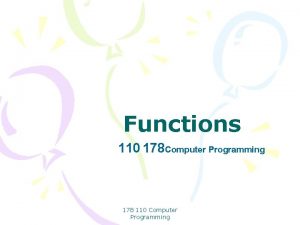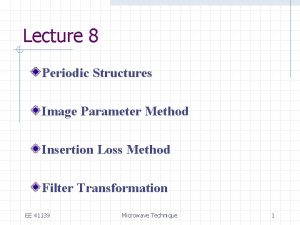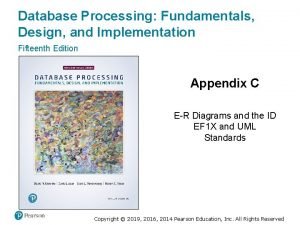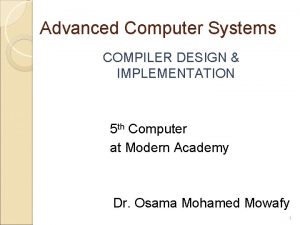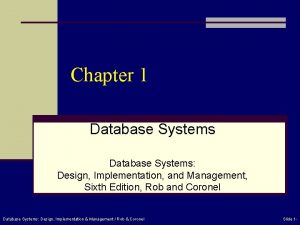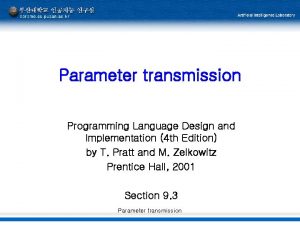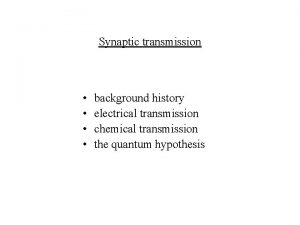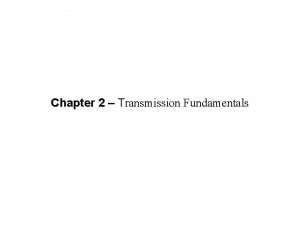Parameter transmission Programming Language Design and Implementation 4












- Slides: 12

Parameter transmission Programming Language Design and Implementation (4 th Edition) by T. Pratt and M. Zelkowitz Prentice Hall, 2001 Section 9. 3

Parameter passing Parameter: A variable in a procedure that represents some other data from the procedure that invoked the given procedure. Parameter transmission: How that information is passed to the procedure. • The parameter is also called the formal argument. The data from the invoking procedure is called the actual argument or sometimes just the argument. Usual syntax: Actual arguments: call P(A, B+2, 27+3) Parameters: Procedure P(X, Y, Z) What is connection between the parameters and the arguments? • Call by name • Call by reference • Call by value • Call by result (or value-result)

Language dependent Difference languages have different mechanisms: • ALGOL - name, value • Pascal - value, reference • C - value (BUT pointers give us reference Constant tension between desire for efficiency and semantic correctness in defining parameter transmission.

Call by name Substitute argument for parameter at each occurrence of parameter: Invocation: P(A, B+2, 27+3) Definition: procedure P(X, Y, Z) {int I; I=7; X = I + (7/Y)*Z; } Meaning: P(X, Y, Z) {int I; I=7; A=I+(7/(B+2))*(27+3); } This is a true macro expansion. Simple semantics, BUT: 1. Implementation. How to do it? 2. Aliases. What if statement of P were: I = A? 3. Expressions versus statements: If we had D=P(1, 2, 3) and a return(42) in P, what does semantics mean? 4. Error conditions: P(A+B, B+2, 27+3)

Implementation of call by name A thunk is the code which computes the L-value and R-value of an argument. For each argument, pass code address that computes both L-values and R-values of arguments. P(A, B+2, 27+3) generates: jump to subroutine P address of thunk to return L-value(A) address of thunk to return R-value(A) address of thunk to return L-value(B+2) address of thunk to return R-value(B+2) address of thunk to return L-value(27+3) address of thunk to return R-value(27+3) To assign to X, call thunk 1, To access X, call thunk 2 To assign to Y, call thunk 3, To access Y, call thunk 4 To assign to Z, call thunk 5, To access Z, call thunk 6 Issue: Assignment to (B+2): How? Call by name is conceptually convenient, but inefficient.

Examples of Call by Name 1. P(x) {x = x + x; } Seems simple enough … Y = 2; P(Y); write(Y) means Y = Y+Y write(Y) prints 4 2. int A[10]; for(I=0; I<10; I++) {A[I]=I; }; I=1; P(A[I]) A[1] = A[1] + A[1] set to 2 3. But: F {I = I + 1; return I; } What is: P(A[F])? P(A[F]) A[F] = A[F]+A[F] A[I++] = A[I++]+A[I++] A[2] = A[3]+A[4] 4. Write a program to exchange values of X and Y: (swap(X, Y)) Usual way: swap(x, y) {t=x; x=y; y=t; } Cannot do it with call by name. Cannot handle both of following: swap(I, A[I]) swap(A[I], I) One of these must fail.

Call by reference Pass the L-value of the argument for the parameter. Invocation: P(A, B+2, 27+3) Implementation: Temp 1 = B+2 Temp 2 = 27+3 jump to subroutine P L-value of A L-value of Temp 1 L-value of Temp 2 This is the most common parameter transmission mechanism. In the procedure activation record, parameter X is a local variable whose R-value is the L-value of the argument.

Call by value Pass the R-value of the argument for the parameter. Invocation: P(A, B+2, 27+3) Implementation: Temp 1 = B+2 Temp 2 = 27+3 jump to subroutine P R-value of A R-value of Temp 1 R-value of Temp 2 In procedure activation record, parameter X is a local variable whose R-value is the R-value of the argument.

Call by reference in C C only has call by value, BUT pointer variables allow for simulating call by reference: P(i, j) passes i and j by value. P(&i, &j) passes L-values of i and j. P(*x, *y) {*x = *y + 1; } arguments are addresses (pointers) Call by result (or value-result): Call by value, AND pass back the final value to argument upon return. Parameter is a local value in procedure. Similar to call by reference, except for aliasing.

In-out semantics Parameters in Ada are based upon use (semantics), not implementation: in - argument value will be used in procedure. out - parameter value will be used in calling program. in out - both uses of arguments and parameters P(X in integer; Y out integer; Z in out integer); begin. . . end; In Ada 83, language definition allowed some latitude in implementation as long as implementation consistent, ok. But this meant that the same program could give different answers from different standards conforming compilers In Ada 95, more restricted: in integer is value, out integer is value-result, composite (e. g. , arrays) is reference.

Example of parameter passing Main {A = 2; B = 5; C = 8; D = 9; P(A, B, C, D); write(A, B, C, D); P(U, V, W, X) {V = U+A; W = A+B; A = A+1; X = A+2; write(U, V, W, X)} Fill in table assume parameters are of the given type: A B C D U V W X print P print main Call by name Call by reference Call by value Call by result When do call by name and call by reference differ? When L-value can change between parameter references. E. g. , P(I, A[I])

 What is parameter in programming
What is parameter in programming Transmission programming languages
Transmission programming languages Language
Language Image parameter method of filter design
Image parameter method of filter design Network security design and implementation
Network security design and implementation Cognitive walkthrough vs heuristic evaluation
Cognitive walkthrough vs heuristic evaluation Cobit 2019 design and implementation exam questions
Cobit 2019 design and implementation exam questions Accessible learning experience design and implementation
Accessible learning experience design and implementation Intune deployment planning, design and implementation guide
Intune deployment planning, design and implementation guide Fundamentals of design
Fundamentals of design Channel design and implementation
Channel design and implementation Advanced compiler design and implementation
Advanced compiler design and implementation Database systems: design, implementation, and management
Database systems: design, implementation, and management
